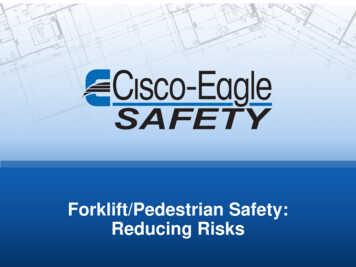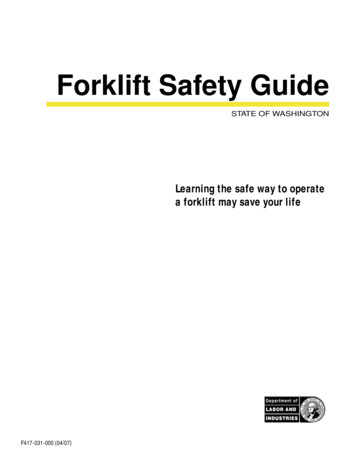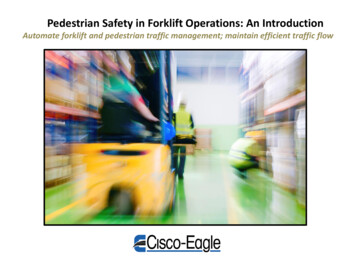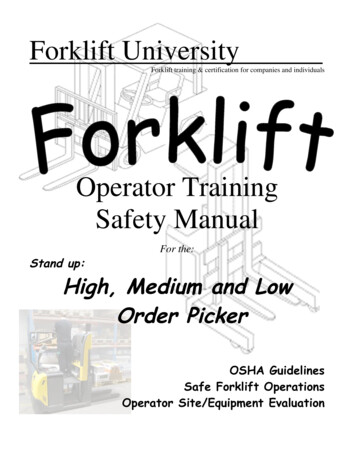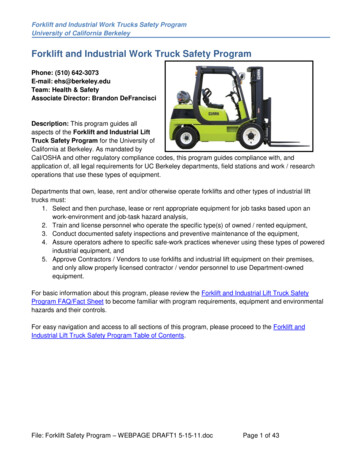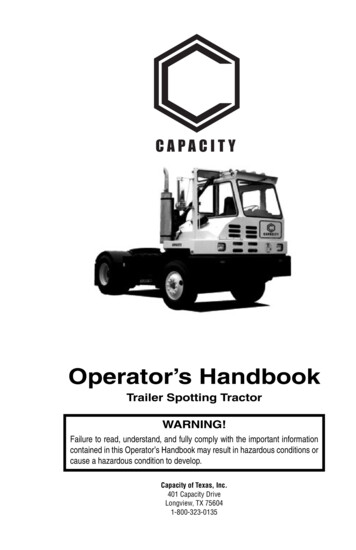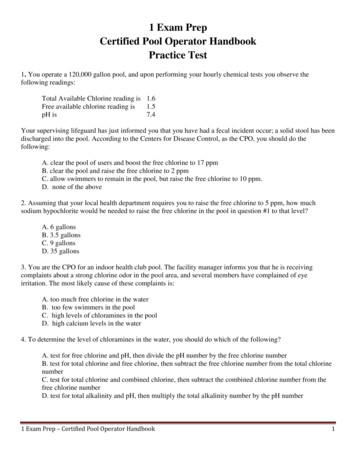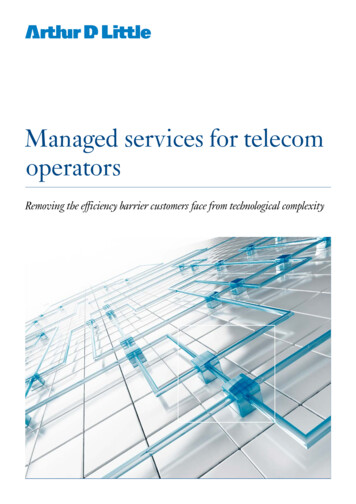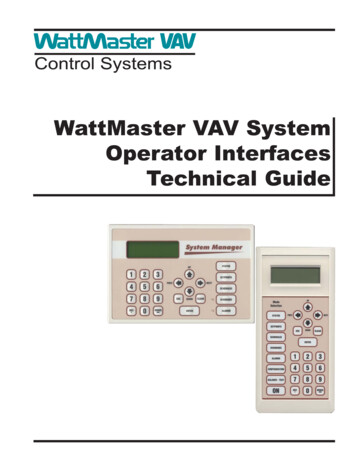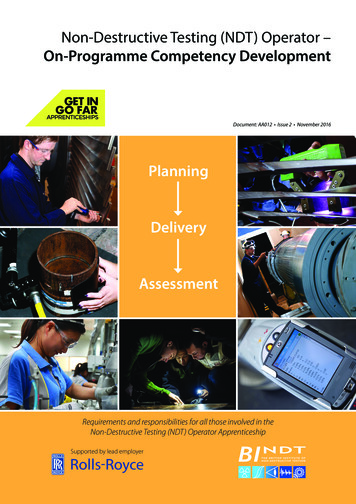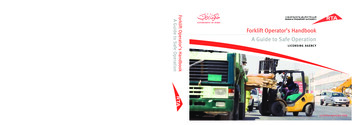
Transcription
Forklift Operator’s HandbookA Guide to Safe OperationForklift Operator’s HandbookA Guide to Safe OperationLICENSING AGENCYRTA Website: www.rta.aeCall Center Tel: 800 90 90 Copyright Roads and Transport Authority (RTA) 20081st Edition November 2008
Forklift Handbook A Guide tO SAFe OPeRAtiON
Table of Contentsintroduction5What this Handbook is About5Why Read this Handbook5How to use this HandbookHow You Will LearnSymbolsPart 1: Licence to Operate a Forklifteligibility CriteriaLearning to Operate a ForkliftPart 2: types and Components of Forkliftstypes of ForkliftsComponents of Forklifts5679991313161
Forklift Handbook A Guide to Safe OPERATIONForklift Controls18Mast and Lifting Mechanism19Manufacturer’s Data Plate19Types and Use of Different Tyres20Rear Wheel Steering21Forklift Attachments22Forklift Safety27Forklift Speed27Refuelling the Forklift28Safe Working Practices29Part 3 :Daily Pre-drive Inspections230
Section: ContentsPart 4 :Forklift OperationMounting and dismountingStart-up Procedure353536Moving ProcedureParking the MachineLoading the Forklift truckWhat Should an Operator Avoid When Operating a Forklift?using AttachmentsCauses of tippingSafety Facts384041454647483
Forklift Handbook A Guide tO SAFe OPeRAtiON4
IntroductionWhat this Handbook is Aboutthis handbook is about the skills and knowledge required to safely operate a forklift. the handbook is foreither a light forklift with an empty weight of not more than 7.5 tonnes, or a heavy forklift with an emptyweight is of more than 7.5 tonnes. the training course for both types of forklifts is the same. the licenceissued will depend on the forklift used for the licence tests at the completion of the course.Why Read this Handbookthis handbook tells you about some of the legal requirements for drivers of light and heavymechanical equipment (forklift) in dubai, along with important safety information, backgroundmaterial, technical information and safe operating procedures.the knowledge test that you must pass to drive a forklift is based on the information in thishandbook. You need to understand it to pass your test.How to use this Handbookthe table of Contents will show you where to find each section. At the end of each section,there is a section called test Yourself Questions to help you check if you have understoodimportant issues.5
Forklift Handbook A Guide to Safe OPERATIONHow You Will LearnLearning to operate a forklift is like any other complex task. If you break the task into small, manageable pieces and do not try tolearn too many things at once, it is much easier. You will: develop the knowledge and skill needed to operate forklifts be shown how to drive and control forklifts safely practise and correct your driving techniques in an increasingly complex set of conditions, so that you are capable of successfullyundertaking your licence test.The length of each stage of learning depends on the amount of practice you have had. Be sure you are confident and competentbefore moving on to the next stage. Your Instructor will advise you when you are ready to move on.How fast and how much you learn will depend on you. You should learn by: reading this handbook carefully attempting all the questions and activities in the handbook observing the operations being performed by your Instructor and on your work site asking questions practising the new skills included in this handbook undertaking the assessment tasks on completion of the training.If there is anything in this handbook you do not understand or do not agree with, do not be afraid to ask your Instructor forassistance.6
introductionSymbolsGraphic symbols are used to guide your learning and identify types of information.the meaning of each symbol is as follows:Caution You must follow instructions to avoid damage to products, a process orsurroundings.Safety You must follow safety procedures or wear protective clothing.?Test Yourself Questions Check that you have understood the information in this section byanswering the questions at the end of each section.7
Forklift Handbook A Guide tO SAFe OPeRAtiON8
Part 1: Licence to Operate a Forklifteligibility Criteriathe eligibility criteria for a licence to operate a forklift are set out below:You may drive a Forklift if you: are over 20 years of age have passed an eye test have undertaken Forklift training until competency is shown and have passed an appropriateknowledge test have passed a practical test pay the appropriate fees.if you meet these criteria, you will be issued with either: a Light Tractor and Mechanical Equipment licence if you have been tested in a forklift withan empty weight of not more than 7.5 tonnes, which permits you to operate light mechanicalequipment only or a Heavy Tractor and Mechanical Equipment licence if you have been tested in a forkliftwith an empty weight of over 7.5 tonnes, which permits you to operate both light andheavy mechanical equipment.Learning to Operate a Forkliftuntil you get your forklift licence, you may only drive a forklift if you are under the supervisionof an instructor who holds a valid licence for the type of vehicle you are driving.9
Forklift Handbook A Guide to Safe OPERATION10Q1 What age must you be to apply for a licence to operate a forklift?Q2 Do you have to pass any tests to obtain a licence to operate a forklift?AQ1 You must be over 20 years of age.AQ2 Yes, a knowledge test and a practical test.?Test Yourself Questions
Part 1: Licence to Operate a Forklift11
Forklift Handbook A Guide tO SAFe OPeRAtiON12
Part 2 : Types and Components of Forkliftstypes of ForkliftsA forklift is a vehicle similar to a small truck that has two metal forks on thefront used to lift cargo. the forklift operator drives the forklift forward untilthe forks push under the cargo, and can then lift the cargo several feet inthe air by operating the forks. the forks, also known as blades or tines,are usually made out of steel and can lift up to a few tonnes, dependingon the capacity of the forklift and the forks.Forklifts are used to: transport loads between areas stack heavy objects load and unload vehicles.there are a wide range of forklifts, including pedestrianoperated and ride on forklifts.Forklifts vary in size, ranging from one tonne capacity forgeneral warehouse type work, up to 50 tonne capacity forshipping container work.13
Forklift Handbook A Guide tO SAFe OPeRAtiONThere are two main types of motors used in forklifts: Internal combustion motors which may be fuelled by petrol, diesel or liquid petroleum gas (LPG). internal combustion poweredforklifts must not be used in confined spaces, as people working in the confined space may be overcome by the fumes. Battery powered electric motors. Gasoline or propane forklifts are sometimes stronger or faster than electric forklifts, but theyare more difficult to maintain. electric forklifts are great for warehouse use because they do not give off dangerous fumes like gaspowered machines.Batteries contain sulphuric acid which is very corrosive to human tissue and the surrounding environment.When you handle a battery you should wear protective clothing, including: eye protection gloves acid resistant boots face mask protective apron.You will need to be careful when lead acid batteries are being recharged because it is possible for a level ofhydrogen to build up that will explode if a spark or naked flame is present.You should take the following steps to reduce the risk of hydrogen building up and creating an explosion: only recharge batteries in designated well ventilated recharging areas make sure there are no flames or sparks around use the isolation switch to ensure that the forklift circuit is open before disconnecting the battery terminals, so nosparking occurs metal tools or fittings must not come in contact with the terminals, as they may create a spark.14
Part 2: types and Components of ForkliftsForklifts are most often used in warehouses, but some are meant to be used outdoors. thevast majority of rough terrain forklifts operate on gasoline, but some use diesel or naturalgas. Rough terrain forklifts have the highest lifting capacity of all forklifts and have heavyduty tyres (like those found on trucks), making it possible to drive them on uneven surfacesoutdoors.Counter Balanced and Non-counter Balanced ForkliftsForklifts are divided into two types based on how they are able to remain stable when they are loaded.these types are Counter Balanced and Non Counter Balanced forklifts.Counter Balanced Forklifts have the weight of the load carriedoutside the wheel base and are counter balanced by the weightof the forklift.in counter balanced forklifts, the weight of the rear of the truckcounterbalances the weight of the load being carried at the frontof the forklift. the front wheels can act as a pivot point on whichthe forklift and load can tip. the greater the weight of the counterbalance of the forklift, then the heavier the load that can belifted. Heavier loads can be lifted if the counter balance is furtherback in the forklift.Non-counter balanced forklifts have the load carried inside the wheel base of the forklift. Non counter balanced forkliftskeep their stability by having the wheels mounted on arms that are on either side of the load when it is being picked upand transported. these are often called straddle lift forklifts.15
Forklift Handbook A Guide to Safe OPERATIONComponents of ForkliftsAll forklifts have similar components but these may be located in different places, depending on the type of forklift: Class 1 forklifts are electric-motor rider trucks, either stand-up operator or seated three-wheel units. Rider units arecounterbalanced and may have cushion or pneumatic wheels. Class 2 forklifts are electric-motor trucks for narrow aisle or inventory stock/order picking applications. They may have extra reachor swing-mast functions. Class 3 forklifts are electric-motor trucks, either walk-behind or standing-rider operated. Automated pallet lift-trucks and high-liftmodels are often counterbalanced. Class 4 forklifts are rider fork trucks, with cabs and seated controls, internal combustion engines, and solid or “cushion” tyres.Class 4 forklifts are sit-down rider, tow tractor lifts. They are supplied with electric or internal combustion engines. Class 5 forklifts are rider fork trucks, with cabs and seated controls, internal combustion engines and pneumatic tyres. They aretypically counterbalanced. Class 6 forklifts are designed for use on rough terrain. Typical applications include agriculture, logging and construction.16
Part 2: types and Components of Forkliftsthese are the key components of a forklift that you will need to know:A mastB lift cylinderC load backrest that prevents the load falling on the operatorD fork carriageE forksLF tilt cylinderAG overhead cageGH driver seatBI drive wheels and axleHJ steering axle and wheelsK counter balanceCKFL warning light.Make sure you know where these arelocated on the type of forklift you willbe operating and how to operate them.JIDE17
Forklift Handbook A Guide tO SAFe OPeRAtiONForklift Controlsthe operating panel of forklift trucks provides the operator with the following features: Inching brake pedal (All terrain models) – this brake pedal is located on the left side of thesteering column and works as a clutch pedal because of the inching valve built in the hydraulicsystem. When the pedal is depressed slightly, the engine power is disconnected. Whendepressed further, brake begins to operate.(NOte: do not overuse the inching brake pedal. it may cause automatic transmission oil tooverheat or the clutch to slip if it is used as a footrest or used for a long time.) Brake Pedal – the lift truck is equipped with a conventional brake pedal as well as an inchingbrake pedal. the conventional pedal is located on the floor to the right of the steering column. Accelerator Pedal – the accelerator pedal is located in a convenient position to the right of thesteering column. Forward- Reverse Lever – the “Forward -Reverse” Lever is used to make a directional change.to move forward, push the lever forward. to back up, pull the lever backwards throughNeutRAL. Gear Shift Lever – the “Gear Shift” lever permits selection of different gear ratios. Pushingthe lever forward places the transmission in 1st speed position. the travel speed should beselected as required to meet the travel conditions and load. Shift these levers to any desiredposition with the clutch pedal depressed all the way. Lift Lever – used to lift and lower the forks. Push forward to lower, pull backward to lift. thelifting speed can be adjusted by varying the engine speed and the distance the lever is moved.The lowering speed can be adjusted only by the distance the lever is moved. Tilt Lever – used to tilt the mast forward and backward. Push forward to tilt forward, pullbackward to tilt backward. The forward or backward tilting speed can be adjusted by theengine speed and the distance that the lever is moved.18
Part 2: types and Components of ForkliftsMast and Lifting Mechanismthe mast is made of two pieces. the outerpiece is connected to the chassis. A pulley isused to extend the mast.When the inner part of the mast moves up ordown, the forks move with double speed inthe same direction. they are linked with a linkchain to the fixed part of the mast. the chaingoes up and over the wheels on the extendingpart, down to the forks. the whole liftingmechanism just needs one motor. With asecond motor, the mast can be tilted forwardand backwards. this is used to move thecentre of gravity closer to the machine, whenlifting heavy loads.Manufacturer’s data PlateYou will need to know how to locate themanufacturer’s data plate on a forklift to findout what the load capacity for your forklift isand other operating limits.19
Forklift Handbook A Guide tO SAFe OPeRAtiONtypes and use of different
Part 2: types and Components of Forklifts 13 types of Forklifts 13 Components of Forklifts 16. Forklift Handbook A Guide tO SAFe OPeRAtiON 2 Forklift Controls 18 Mast and Lifting Mechanism 19 Manufacturer’s data Plate 19 types and use of different tyres 20 Rear Wheel Steering 21 Forklift Attachments 22 Part 3 : Forklift Safety 27 Forklift Speed 27 Refuelling the Forklift 28 Safe Working .
